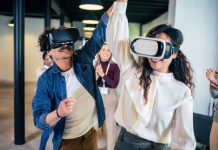Making the best investments in employee training and professional development requires smart allocation of resources. Using advanced e-learning technologies for employee training may not at first seem worthwhile; however, they offer great advantages for organizations willing to think ahead. Not only can e-learning better leverage your most knowledgeable experts’ and trainers’ time and efforts, using 3-D technologies to create training assets also provides a much greater return on every training dollar spent. And 3-D is just the beginning. Simulations and serious games motivate employees and make an enormous impact on their behaviors, and augmented reality can bridge the training-operations gap.
In many high-stakes and fast-moving industries such as the high-tech and oil and gas industries, greater job complexity and knowledge gaps among young workers are huge challenges. These industries are responding by devoting resources to technologically advanced training methods.
Evergreen E-Learning Efficiencies
Do you have a few employees or trainers with so much organizational or domain expertise that you worry the business would be lost without them? Develop e-learning to transfer that implicit knowledge into explicit training assets that can transform your entire organization. With modular, learner-centered instructional design and living assets such as 3-D media, your employees and organization can gain all the benefits of e-learning, minimizing change management expenses.
E-learning that is mobile and modular not only allows for easier updates, it also encourages busy professionals to selectively engage with specific topics that target their needs and interests. If employees are confident that a training activity will be easily accessible, brief, and relevant to their work, they are much more likely to engage in it. Developing learner-centered training has similar benefits as modular training. Learner-centered training is focused on enhancing employee skills and procedures from the learner’s perspective, as opposed to focusing on product or service details that change with every new release or new customer. This makes the material much more relevant to learners. Plus, that material will stay fresh for much longer.
Even when product details change rapidly, for instance, in manufacturing or technical businesses, using rich media such as 3-D assets allows for quick, cost-effective change management. A 3-D model of a product can be the source for a huge range of product imagery, and can be manipulated, updated, and re-used as the product changes. We call this a living asset because, unlike photography, there are no limits to the amount of detail, resolution, angles, or lighting conditions that can be produced from one 3-D model. And, of course, you can re-use 3-D assets in marketing, sales, and any other division of your organization, as well.
First-person, Mission-Critical Simulations That Impact Employee Behavior
Richly interactive training now can incorporate advanced simulation technologies so trainees can be prepared for real-life scenarios. They can learn complex procedures and processes quickly and without the risk factors involved in real-life situations or real equipment. And when simulation technologies are delivered within a serious games environment, they create an immersive world in which the learner is in the first-person position, making mission-critical decisions.
Training within real-world scenarios rewards the application of both newly acquired skills and previous experience, so learners develop competencies rather than just memorize correct answers. Simulations long have been used as a training method in high-risk or highly instrumented environments such as flight or medical training. However, you don’t need life-threatening tasks in order to benefit from simulations and serious games. Education research has shown that adult learners retain significantly more instruction and perform better on competency tests by experiencing simulated real-life scenarios in which they can practice a task, and even fail, without risk. More and more employees, especially those who grew up with gaming technologies, respond with enthusiasm to the challenge of serious games.
Like the oil and gas industry, many organizations require flexible and highly effective training delivery options that change employee behaviors. Simulation training is ideal for highly instrumented environments, but it is also ideal for blending hard and soft skills. One recent example of such training we’ve developed includes a serious game in which learners train on both inspection tasks and the soft skills involved in communicating with those being inspected. Serious games emphasize decision-making, critical thinking, problem solving, and the correct application of skills to a particular situation. Because it provides practice-oriented training, it makes the most of employees’ training hours, and can more efficiently develop their skills than time-consuming synchronous classroom training.
Bridging the Training-to-Operations Gap With Augmented Reality
The most advanced professional development no longer has to interrupt operations at all; it can be integrated into operations. By integrating the real world with the virtual, augmented reality (AR) anchors information when and where people need it. Whereas a simulation is an entirely computer-generated experience, AR superimposes computer-generated information or imagery over the user’s view of the real world. Influential innovators such as Google, Microsoft, HP, and Logitech all are working on augmented reality displays that help with way-finding and technical visualizations, among other applications.
Job aids and other training tools delivered via AR have many benefits:
- They can be easily and remotely updated whenever equipment or procedures change.
- They mean less reliance on synchronous classroom training.
- They enable employees to quickly synchronize their tasks with appropriate co-workers, equipment, and precautions.
Just as Boeing is equipping its workers with virtual-reality glasses to assemble 747s, it’s very possible that “augmented” employees soon may be a standard in many industries.
Valuable organizational efficiencies gained by using AR include a seamless transition between training and operations. The same assets developed for training can be used by workers to understand their environment and feed them live digital readouts and instructions on what to do next and how to do it right. For example, the same procedural steps used to train employees can be re-purposed into a procedure management system that to monitors and tracks employee performance for safety compliance purposes or professional development opportunities. AR also can integrate with automated systems to provide employees with enhanced environmental awareness and on-demand instructions relevant to their task, or act as a virtual health, safety, and environment guide to walk new trainees through safety and compliance procedures, pointing out hazardous areas and showing what protective equipment to wear.
The merging of physical and digital worlds is made possible by some of the most advanced e-learning technologies, and it has the potential to advance employee development and technical acumen in many creative, cost-effective ways. As many organizations are discovering, 3-D assets, simulations, and augmented reality visualizations offer vast new possibilities for improving professional development and training.
Oliver Diaz is CEO and founder of FuelFX, a 3-D multimedia and interactive firm that brings a unique insight into business culture and how to effectively communicate both inside and outside that culture. He and his team at FuelFX are a mix of creative content providers and technologists. They employ state-of-the-art 3-D communication technology such as augmented reality, virtual reality, digital laboratory simulators, parallax Web development, and 3-D animations for the world’s largest energy, high-tech and oil and gas companies for improved training, business intelligence, and agility.




